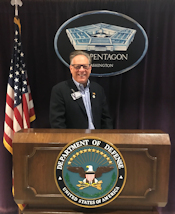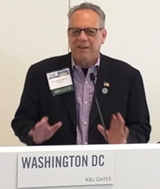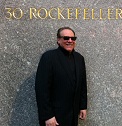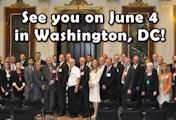NanoBusiness Alliance Interview – Clayton Teague, Director, NNCO
Posted on January 3rd, 2011 | No Comments »
We finish our 2010 interview series with one of the most influential people in our Nanotechnology Community, Clayton Teague. We would like to commend Clayton for the tremendous job he has done implementing the NNI during the past 10 years.
Clayton Teague http://www.nsti.org/outreach/NNCO/ is Director of the National Nanotechnology Coordination Office (NNCO). Established in 2001, NNCO is the secretariat to the Nanoscale Science, Engineering and Technology (NSET) Subcommittee of the National Science and Technology Council (NSTC). As such, the NNCO provides day-to-day technical and administrative support to the NSET Subcommittee and assists in the preparation of multi-agency planning, budget, and assessment documents such as the annual National Nanotechnology Initiative supplements to the President’s Budgets.
NNCO is the point of contact on Federal nanotechnology activities for government organizations, academia, industry, professional societies, foreign organizations, and others, facilitating exchanges of technical and programmatic information. In addition, the NNCO develops and makes available printed and other materials as directed by the NSET Subcommittee and maintains the NNI Web site, www.nano.gov.
SW: Hello, Clayton! Thanks for taking time to speak with the NanoBusiness Alliance today. How are things going at the NNCO? We take it you’ve been very busy this year.
CT: Yes, it has been a busy and productive year for both the NNI and the NNCO. This year has presented challenges and opportunities that represent the culmination of nearly a decade of work. The NSET Subcommittee and its members have certainly risen to the challenge to close out the first ten years of the NNI with a new NNI Strategic Plan and an updated NNI strategy for nanotechnology-related environmental, health, and safety (EHS) research. In addition to these critical documents, the planning and convening of five workshops and the collaborative efforts required in drafting the subsequent workshop reports, 2010 has been a very busy year for the NNCO.
SW: Leading up to the 10-year anniversary of the NNI and the NNCO, what have been the major accomplishments of your office over the past decade?
CT: There have been many, and I feel privileged to have had the opportunity to work with and to learn about the variety of roles, responsibilities, and cultures of the NNI member agencies. In terms of being privileged and learning, I am equally indebted to all the great staff I have worked with here at the NNCO. Among the major accomplishments, I would highlight the support the NNCO has provided for many NNI workshops and for developing the resulting workshop reports, the annual NNI supplements to the President’s Budget, and the development and maintenance of the NNI’s website, www.nano.gov. I am pleased that we have nearly completed a major redesign of the NNI’s website. This site, due to be released in early 2011, will feature enhancements in both appearance and functionality. This is one of the major interfaces between the NNCO, the NSET, academia, industry, and of course, the public. We feel that the updated and reorganized structure of this website will make it more user-friendly, and as such, an invaluable resource for anyone interested in not only the NNI, but in nanotechnology writ large.
As some degree of recognition of the NNCO contributions, the NSET Subcommittee has continued to increase annual funding support for the NNCO – which comes directly from the member agencies’ research funds! The result of that increasing level of support is that the NNCO staff in the last decade has grown from three people to a staff of 11. This increased staffing happened over time, in response to the growing needs of the Subcommittee, the formation of the four working groups by the Subcommittee, and the increased number of workshops and activities in the NNI. As the NNI and nanotechnology as a field have grown in terms of prominence and public awareness, we have seen an increased need for staff to liaise with the media, with industry, with states, and of course with Congress.
SW: What are the key U.S. nanotechnology initiatives underway today?
CT: Under the direction of the White House’s Office of Science and Technology Policy (OSTP), the NNI has launched three “Nanotechnology Signature Initiatives” in fiscal year (FY) 2011, covering the areas of Nanoelectronics, Sustainable Nanomanufacturing, and Solar Energy Collection and Conversion. These topics areas are not only prime targets to be at the forefront of a nanotechnology-driven industrial revolution, but they are well-suited for the increased interagency cooperation and collaboration and public/private partnerships that epitomize the NNI.
Additionally, a major effort has been underway under the direction of the NSET Subcommittee’s Nanotechnology Environmental and Health Implications (NEHI) Working Group to respond to the need to identify the potential risks of nanomaterials and the appropriate research strategies to address them. Thanks to the response of the NNI participating agencies, we have seen nearly a fourfold increase in the investment in EHS research, from $35 million in FY 2005 to $117 in the FY 2011 request. Nanomanufacturing has also seen a significant increase, from $34 million in FY 2006 to $101 million in the FY 2011 request. This nanomanufacturing increase is consistent with the recommendations we’ve heard from both the business community and from the President’s Council of Advisors for Science and Technology.
SW: What is your sense of how policymakers view the importance of nanotechnology with respect to U.S. economic performance and international competitiveness?
CT: Indications from the joint, annual R&D priorities memorandum to all agencies from the Office of Management and Budget and OSTP, as well as from the Administration’s white paper on innovation, send a strong, positive message about the future of nanotechnology. In both cases, nanotechnology was given a high priority and is viewed as being important in terms of both U.S. economic growth and international competitiveness. In general, I feel that it’s viewed as one of the more promising technologies, even among the other emerging technology fields like synthetic biology and biotechnology.
SW: Can you give us some insights into how the NNCO works with academic institutions doing nanotechnology research and the importance of this research?
CT:The NNCO’s main responsibilities in regard to academic institutions are to provide referrals to the appropriate NNI participating agencies and programs in response to direct inquiries, and to provide information on current solicitations and partnership opportunities on the nano.gov website. We believe the new website will serve as an excellent platform for users to ascertain information on funding opportunities throughout the NNI agencies. We also try to work with the NSF, DOE, NIST, and NIH centers that are housed at academic institutions and national laboratories across the country, to help increase public awareness of these centers and to highlight the research going on there.
SW: How does the NNCO view what’s going in on the private sector with respect to companies engaged in nanotechnology research and development?
CT: We view the private sector as an essential component in the R&D process, working with the government and academia to motivate and conduct forefront research and development, serving as the linchpin in successful technology transfer, and finally moving to commercialization. Private companies are invaluable to U.S. efforts in nanotechnology, because they are best suited for taking research results from the lab and integrating them into prototypes and marketable products. This translation of basic research resulting in applications is critical to realizing nanotechnology’s promise for enhancing our national security, public health, and economic competitiveness. Among the most important economic metrics for measuring the success of nanotechnology R&D are: the number of successful companies formed, the number of new jobs added, and the amount of new value added to the economy. We’ve had varying degrees of success in measuring progress in these areas. I believe the private sector has shown great progress and proven success in terms of forming companies and creating jobs, but the overall economic impact has yet to be assessed accurately. We are looking at a number of options to develop the appropriate metric to assess some of the economic impact numbers and to determine the best path forward to help launch nanotechnology into the forefront of the new economy. Getting the community to agree on what metrics are to be used in assessing economic impact is still in discussion as we work to achieve consensus.
SW: What are the biggest challenges facing the NNCO and the nanotech community today? From the NNCO’s perspective, how can the nanotech community do a better job of educating the public on nanotechnology?
CT: We at the NNCO – along with the rest of the nanotech community – are still trying to communicate with the general public about the benefits and the potential risks of nanotechnology in a positive way that the public can understand. A recent Scientific American article surveyed more than 21,000 adults worldwide that Scientific American described as “a supportive and science-literate crowd” and found that nanomaterials are viewed as the second most pressing safety concern we face today, after nuclear materials. For perspective, this number was skewed because Europeans saw nuclear power as much more dangerous than nanomaterials. But Americans overall thought nanotechnology was riskier. This result points to our need to more effectively communicate with and inform the public on nanotechnology opportunities and issues. Early reports from a study underway by Lux Research indicate that Europe has done a better job of communicating both the risks and benefits of nanotechnology, which may be why the European response to the survey was less negative toward nanotechnology than the American response. However, the door to more effective communications has not yet closed; the Scientific American study also revealed that scientists are viewed as the most trusted professionals. So we – the scientific and industrial communities – are still in the position to help correct any misperceptions about nanotechnology. As an example, members of the public don’t tend to see their iPods or their computers as nanotechnology-enabled products, but rather as just cool, new products. Raising awareness of how nanotechnology is playing a critical role in bringing products valued by the public is something all involved with the technology need to be doing. It is a role I think is particularly important for industry. Some companies have become wary of advertising or labeling their products as nanotechnology-enabled. While this is a justifiable reaction given the public’s concerns about nanotechnology, it has the potential to add fuel to the fire; what seems like good business sense in the beginning can be misconstrued as intentionally deceptive at a later date.
SW: How do you see the NNCO evolving in coming years?
CT: There is a growing interest in better serving both industry and the states and to take more steps toward public outreach and communications. The NNCO will also continue to work with the NSET Subcommittee as it forges a path forward to an increased level of collaboration among the member agencies. In order to better facilitate meaningful interactions with industry sectors focusing on nanotechnology and its applications and with state organizations, we are working with the NNI member agencies to reach out to both industry sectors and state organizations. Several of the NNI member agencies have had some initial meetings with the Environmental Council of States to enable better communication between the Federal and State efforts in nanotechnology-related EHS regulatory issues. We also plan to increase our efforts to work with regional, state, and local (RSL) initiatives, in part by making more information about RSL initiatives available through our website.
Our newly appointed Deputy Director, Sally Tinkle, is also tasked with serving as the EHS Coordinator. Through her leadership, we have already increased our efforts in interagency collaboration on EHS issues. Also, per the PCAST recommendations, we are increasing our coordination and collaboration on standards activities. This follows the formation of the NSTC Subcommittee on Standards, which is being led by NIST and chaired by the NIST Director, Pat Gallagher.
SW: What is the best way for NanoBusiness Alliance members to stay current with what the NNCO is doing and what can our members do to help the NNCO in the future?
CT: In part, by keeping abreast of our website and social media tools, such as our Twitter feed and our YouTube videos. We also encourage NbA members to attend our workshops and events and to participate in online activities like the Strategy Portal, strategy.nano.gov, established earlier this year to garner stakeholder input for the new NNI Strategic Plan and the updated NNI Strategy for Nanotechnology-Related EHS Research. Furthermore, we would be amenable to expanding regular meetings to discuss issues of mutual interest, perhaps by adding an agenda item to the annual NbA conference schedule for a meeting with, or presentations by, key NNCO staff. Toward NbA members helping the NNCO, we’d like to hear about the NbA’s current activities and plans. Please let me know of ways the NNCO could serve the NbA better; critiques of website content, suggestions for publication topics, mechanisms for working with industry sectors. With our new website and social media platforms, we would really like to highlight NbA accomplishments and new directions being taken by member companies, so don’t hesitate to contact our Communications and Outreach office (mepstein@nnco.nano.gov) to send us your latest news. When you succeed, we succeed!
Remember to follow us on Twitter @NNInanonews
SW: Thanks for your time today, Clayton. We wish you and the NNCO all the best in the future.
Happy Holidays and Happy New Year to you and your family.
Regards,
Vincent Caprio “Serving the Nanotechnology Community for Over a Decade”
Executive Director
NanoBusiness Alliance
203-733-1949
vincentcaprio@nynanobusiness.org
www.nynanobusiness.org
www.vincentcaprio.org




